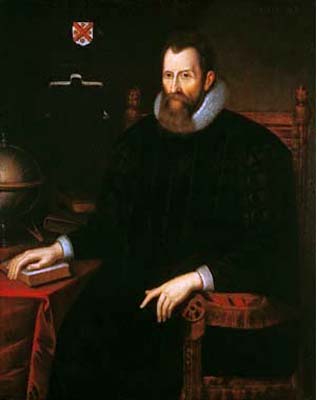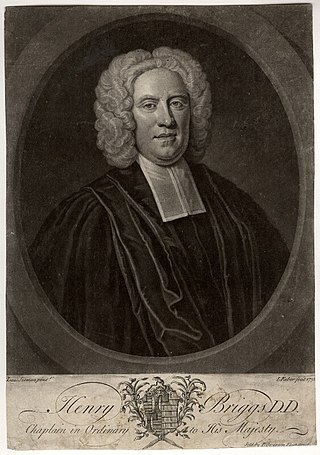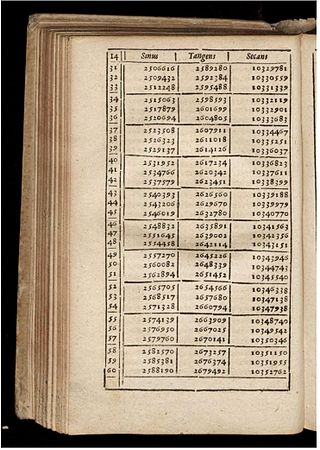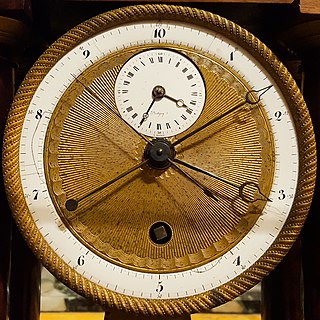
The decimal numeral system is the standard system for denoting integer and non-integer numbers. It is the extension to non-integer numbers of the Hindu–Arabic numeral system. The way of denoting numbers in the decimal system is often referred to as decimal notation.

A difference engine is an automatic mechanical calculator designed to tabulate polynomial functions. It was designed in the 1820s, and was first created by Charles Babbage. The name difference engine is derived from the method of divided differences, a way to interpolate or tabulate functions by using a small set of polynomial co-efficients. Some of the most common mathematical functions used in engineering, science and navigation are built from logarithmic and trigonometric functions, which can be approximated by polynomials, so a difference engine can compute many useful tables.

John Napier of Merchiston., nicknamed Marvellous Merchiston, was a Scottish landowner known as a mathematician, physicist, and astronomer. He was the 8th Laird of Merchiston. His Latinized name was Ioannes Neper.

In mathematics, the logarithm is the inverse function to exponentiation. That means that the logarithm of a number x to the base b is the exponent to which b must be raised to produce x. For example, since 1000 = 103, the logarithm base 10 of 1000 is 3, or log10 (1000) = 3. The logarithm of x to base b is denoted as logb (x), or without parentheses, logb x, or even without the explicit base, log x, when no confusion is possible, or when the base does not matter such as in big O notation.

Jean-Charles, chevalier de Borda was a French mathematician, physicist, and Navy officer.

A decimal separator is a symbol used to separate the integer part from the fractional part of a number written in decimal form. Different countries officially designate different symbols for use as the separator. The choice of symbol also affects the choice of symbol for the thousands separator used in digit grouping.

In mathematics, the common logarithm is the logarithm with base 10. It is also known as the decadic logarithm and as the decimal logarithm, named after its base, or Briggsian logarithm, after Henry Briggs, an English mathematician who pioneered its use, as well as standard logarithm. Historically, it was known as logarithmus decimalis or logarithmus decadis. It is indicated by log(x), log10(x), or sometimes Log(x) with a capital L; on calculators, it is printed as "log", but mathematicians usually mean natural logarithm (logarithm with base e ≈ 2.71828) rather than common logarithm when writing "log". To mitigate this ambiguity, the ISO 80000 specification recommends that log10(x) should be written lg(x), and loge(x) should be ln(x).

Henry Briggs was an English mathematician notable for changing the original logarithms invented by John Napier into common logarithms, which are sometimes known as Briggsian logarithms in his honour. The specific algorithm for long division in modern use was introduced by Briggs c. 1600 AD.

Mathematical tables are lists of numbers showing the results of a calculation with varying arguments. Trigonometric tables were used in ancient Greece and India for applications to astronomy and celestial navigation, and continued to be widely used until electronic calculators became cheap and plentiful, in order to simplify and drastically speed up computation. Tables of logarithms and trigonometric functions were common in math and science textbooks, and specialized tables were published for numerous applications.
A numerical digit is a single symbol used alone or in combinations, to represent numbers in a positional numeral system. The name "digit" comes from the fact that the ten digits of the hands correspond to the ten symbols of the common base 10 numeral system, i.e. the decimal digits.

Baron Gaspard Clair François Marie Riche de Prony was a French mathematician and engineer, who worked on hydraulics. He was born at Chamelet, Beaujolais, France and died in Asnières-sur-Seine, France.
The significand refers to the first (left) part of a number in scientific notation or related concepts in floating-point representation, consisting of its significant digits. Depending on the interpretation of the exponent, the significand may represent an integer or a fraction.
Prosthaphaeresis was an algorithm used in the late 16th century and early 17th century for approximate multiplication and division using formulas from trigonometry. For the 25 years preceding the invention of the logarithm in 1614, it was the only known generally applicable way of approximating products quickly. Its name comes from the Greek prosthesis (πρόσθεσις) and aphaeresis (ἀφαίρεσις), meaning addition and subtraction, two steps in the process.

Decimal time is the representation of the time of day using units which are decimally related. This term is often used specifically to refer to the French Republican calendar time system used in France from 1794 to 1800, during the French Revolution, which divided the day into 10 decimal hours, each decimal hour into 100 decimal minutes and each decimal minute into 100 decimal seconds, as opposed to the more familiar standard time, which divides the day into 24 hours, each hour into 60 minutes and each minute into 60 seconds.

Adriaan Vlacq (1600–1667) was a Dutch book publisher and author of mathematical tables. Born in Gouda, Vlacq published a table of logarithms from 1 to 100,000 to 10 decimal places in 1628 in his Arithmetica logarithmica. This table extended Henry Briggs' original tables which only covered the values 1-20,000 and 90,001 to 100,000. The new table was computed by Ezechiel de Decker and Vlacq who calculated and added 70,000 further values to complete the tables. This table was further extended by Jurij Vega in 1794, and by Alexander John Thompson in 1952.

The history of logarithms is the story of a correspondence between multiplication on the positive real numbers and addition on the real number line that was formalized in seventeenth century Europe and was widely used to simplify calculation until the advent of the digital computer. The Napierian logarithms were published first in 1614. E. W. Hobson called it "one of the very greatest scientific discoveries that the world has seen." Henry Briggs introduced common logarithms, which were easier to use. Tables of logarithms were published in many forms over four centuries. The idea of logarithms was also used to construct the slide rule, which became ubiquitous in science and engineering until the 1970s. A breakthrough generating the natural logarithm was the result of a search for an expression of area against a rectangular hyperbola, and required the assimilation of a new function into standard mathematics.
A timeline of numerals and arithmetic.

Mirifici Logarithmorum Canonis Descriptio and Mirifici Logarithmorum Canonis Constructio are two books in Latin by John Napier expounding the method of logarithms. While others had approached the idea of logarithms, notably Jost Bürgi, it was Napier who first published the concept, along with easily used precomputed tables, in his Mirifici Logarithmorum Canonis Descriptio.
Ezechiel de Decker was a Dutch surveyor and teacher of mathematics.

Robert Barker was a British physician and inventor. He was a Fellow of the Royal Society from 1732.













